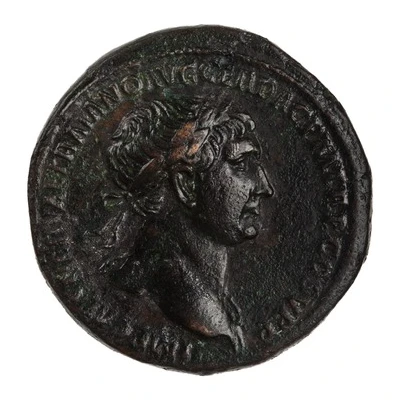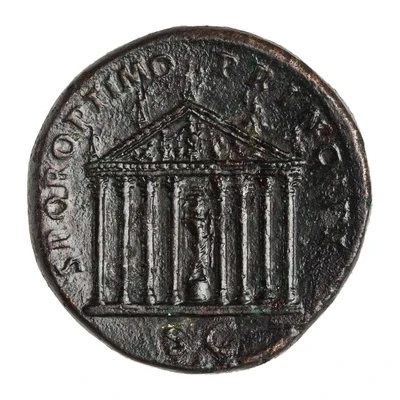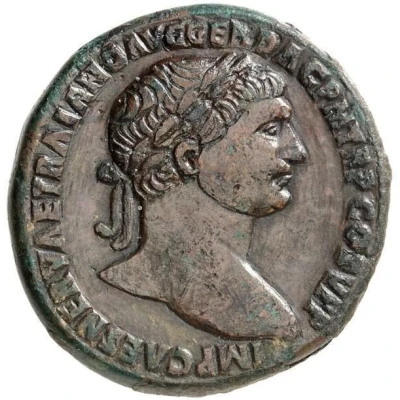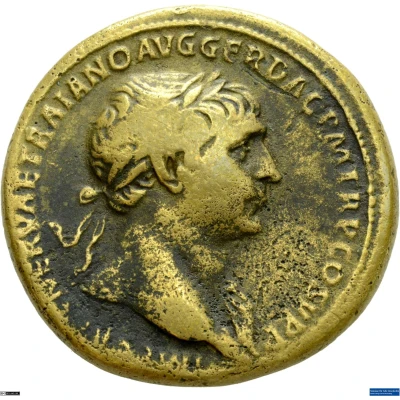
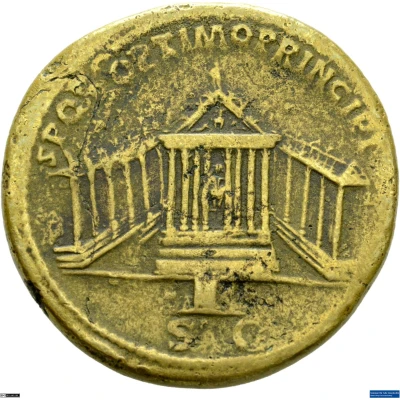

© Münzsammlung des Seminars für Alte Geschichte, Albert-Ludwigs-Universität Freiburg (CC BY-NC-SA 3.0 DE)
Sestertius - Trajan S P Q R OPTIMO PRINCIPI S C; Jupiter and Victory
| Bronze | 22.1 g | 32.5 mm |
| Issuer | Rome › Roman Empire (27 BC - 395 AD) |
|---|---|
| Emperor | Trajan (Marcus Ulpius Traianus) (98-117) |
| Type | Standard circulation coin |
| Years | 103-111 |
| Value | 1 Sestertius = ¼ Denarius |
| Currency | Denarius, Reform of Augustus (27 BC – AD 215) |
| Composition | Bronze |
| Weight | 22.1 g |
| Diameter | 32.5 mm |
| Shape | Round (irregular) |
| Technique | Hammered |
| Demonetized | Yes |
| Updated | 2024-10-06 |
| Numista | N#253540 |
|---|---|
| Rarity index | 97% |
Reverse
Jupiter seated in center of octastyle temple; architrave decorated with figure of Jupiter among other figures; figure holding spear between two Victories on roof.
Script: Latin
Lettering: S P Q R OPTIMO PRINCIPI S C
Translation:
Senatus Populusque Romanus Optimo Principi. Senatus Consultum.
The senate and the Roman people to the best of princes. Decree of the senate.
Comment
Mass varies: 11.12–26.74 g;Diameter varies: 29–35 mm;
Source: Online Coins of the Roman Empire (OCRE)
RIC I# 577 (altar in front)
RIC I# 577 var. (no altar)
Sestertius of the Roman emperor Trajan with architectural reverse type. Rare.
The temple of Jupiter Victor was dedicated on the Palatine Hill 13 April 294 (or 293) BC. This octastyle Corinthian order temple makes its first numismatic appearance on denarii of Domitian struck in AD 94, probably marking the re-building of the temple after the devastating fire of AD 80. Trajan used the temple to symbolize his military victories at the time of his decennalia, at which time the large courtyard altar and side colonnades may have been added. Elagabalus later re-dedicated the building to his eastern god Sol-Elagabal, and in the 10th century the sacred site saw new use as the church of St. Maria de Palladio.
Interesting fact
One interesting fact about this coin is that it features a depiction of Jupiter, the Roman god of thunder, on one side, and Victory on the other. This symbolism represents the power and triumph of the Roman Empire during the reign of Trajan, who was known for his military conquests and expansion of the empire.
